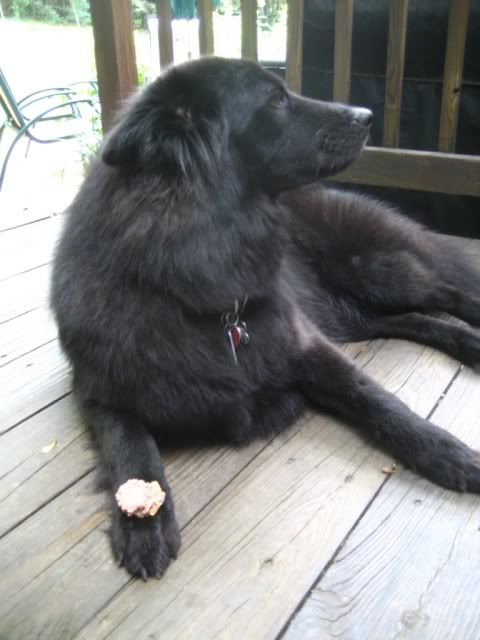How do you deal with self-rewarded undesirable behaviors?
I ask this because I'm genuinely interested. For our dogs we've always used mainly positive training. We'd never lay a hand on any dog (as correction or punishment... obviously petting and belly rubs aren't what I'm getting at!) Boo is never corrected when she's learning a new trick or practicing tricks. But she gets an 'uh uh' if she does something naughty and we catch it in the act. (Think trying to dart out the door, etc) She's a sensitive dog, so usually a reprimand of that degree (just one 'epp epp' or 'uh uh') and she gets it. Obviously followed by reward when she does it right.
But I know that some out there are all for ignoring bad behavior and 'replacing' it with good. For example, ignore jumping up, reward 4 paws on the floor. That makes complete sense. I was wondering what these trainers do when confronted with self rewarded unwanted behaviors. For example, your dog sees a loaf of bread on the counter, and while you aren't paying a bit of attention, the loaf is devoured. Rover has just been self-rewarded. He jumps, he gets yummy food. Now he likes this game. You clean up the mess, don't say anything (that's what I would do), but now Rover is getting brave so he decides that the steak on the counter looks good. You turn around and catch him with his paws on the table. What would an all positive dog trainer do? Is there a place and time for correction (not physical, just verbal) in your books or are you truly all positive?
Same idea goes for things such as escaping a yard, trash digging, barking at the mailman, door bolting, counter surfing (as mentioned), and jumping on furniture if not allowed.
I was just pondering that, and of course wondering what the general consensus is. Obviously not trying to be the least bit "challenging" , just wondering. And if you managed to correct these behaviors with no corrections (forgive the wording!), how'd you do it?
Obviously not trying to be the least bit "challenging" , just wondering. And if you managed to correct these behaviors with no corrections (forgive the wording!), how'd you do it?
Luckily for us, we haven't had an issue with Boo *knocks on wood*, but I'm interested in learning anyway.
-GoingNowhere
I ask this because I'm genuinely interested. For our dogs we've always used mainly positive training. We'd never lay a hand on any dog (as correction or punishment... obviously petting and belly rubs aren't what I'm getting at!) Boo is never corrected when she's learning a new trick or practicing tricks. But she gets an 'uh uh' if she does something naughty and we catch it in the act. (Think trying to dart out the door, etc) She's a sensitive dog, so usually a reprimand of that degree (just one 'epp epp' or 'uh uh') and she gets it. Obviously followed by reward when she does it right.
But I know that some out there are all for ignoring bad behavior and 'replacing' it with good. For example, ignore jumping up, reward 4 paws on the floor. That makes complete sense. I was wondering what these trainers do when confronted with self rewarded unwanted behaviors. For example, your dog sees a loaf of bread on the counter, and while you aren't paying a bit of attention, the loaf is devoured. Rover has just been self-rewarded. He jumps, he gets yummy food. Now he likes this game. You clean up the mess, don't say anything (that's what I would do), but now Rover is getting brave so he decides that the steak on the counter looks good. You turn around and catch him with his paws on the table. What would an all positive dog trainer do? Is there a place and time for correction (not physical, just verbal) in your books or are you truly all positive?
Same idea goes for things such as escaping a yard, trash digging, barking at the mailman, door bolting, counter surfing (as mentioned), and jumping on furniture if not allowed.
I was just pondering that, and of course wondering what the general consensus is.
Luckily for us, we haven't had an issue with Boo *knocks on wood*, but I'm interested in learning anyway.
-GoingNowhere

